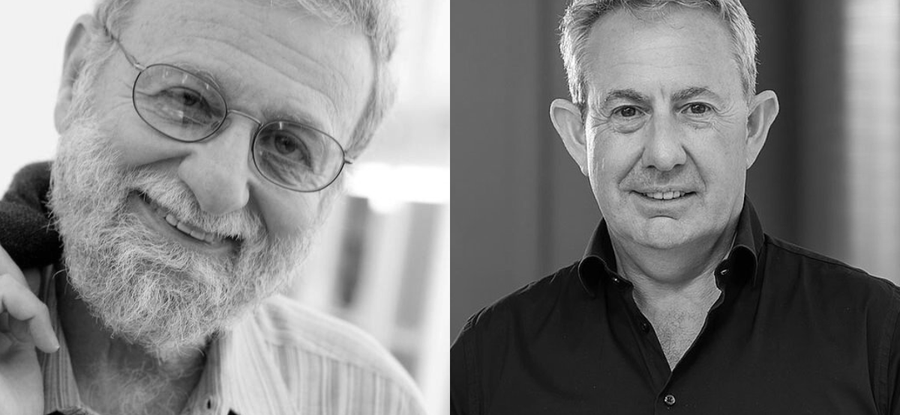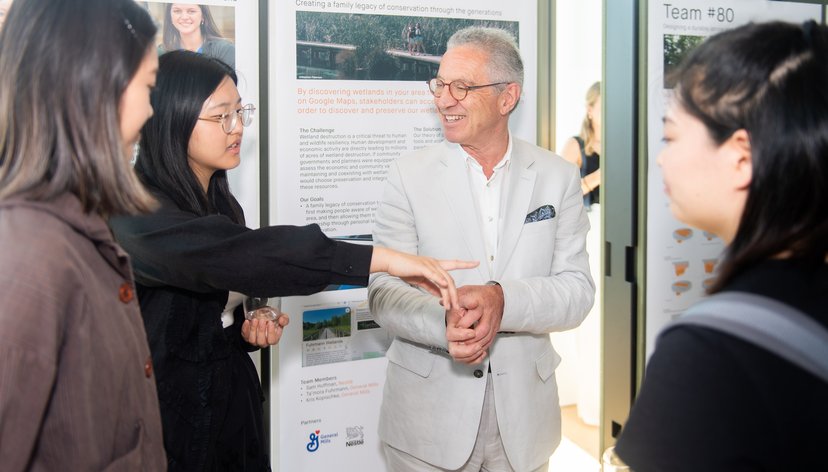Two leading experts in design, Don Norman and Sean Carney, kicked off a new series of public webinars hosted by the RCA and Design for Good Academy, exploring Don’s shift from ‘human-centred’ to ‘humanity-centred design’, advice for early-career practitioners and more.
On Tuesday 6 February, RCA Executive Education hosted the first of three public “Masterclass Talks” as part of the RCA x Design for Good Academy, a live international online course for members of the Design for Good Alliance.
Over 1,500 people from 75 countries, alongside an auditorium full of RCA students, signed up to watch Don Norman, one of the pioneering advocates for user-centred design who’s often referred to as the "godfather of UX [user experience]”, in conversation with Sean Carney, an international brand and design thought leader.
Distinguished Professor Emeritus of Cognitive Science and Psychology and founding director of the Design Lab at the University of California, San Diego, Don has been an engineer, cognitive scientist, designer, and industry executive (Apple VP and co-founder and principal at Nielsen Norman group).
Co-Founder and Advisory Council Member of Design for Good, Sean discussed with Don the current state of design, where he sees the future headed for the field, career advice for designers and more.
Here’s our five key takeaways from the conversation:
1. Human-centred design must go further
“People ask me why I said we should want to do ‘humanity-centred’ design, as opposed to life-centred or people-centred or planet-centred… I chose humanity, and I define humanity to mean anything that impacts life, all life on this planet, and that includes therefore the ecological system to the planet.”
Don discussed his recent shift toward humanity-centred design (outlined in his latest book, Design for a Better World), acknowledging the limitations of human-centred design in addressing broader ecological and societal issues.
If human-centred design is ‘HCD’, Don posited humanity-centred design is H plus CD; it is human-centred plus more, stressing the interconnectedness of individuals within larger social, cultural, and environmental contexts.

RCA Design 360 students live stream the talk in Kensington, hosted by Nick de Leon
2. Design with people, not for them
“We don't understand each other completely…you can't understand or really get in the head of somebody else…especially when you're with a different culture. It's very important that the people from that other culture be part of the design team.”
The two designers advocated for participatory design, particularly when addressing complex societal problems, and underscored the need for designers to collaborate closely with communities, stakeholders and end-users throughout the design process.
Sean drew upon his experience with Design for Good, whose global design projects aim to address the United Nations Sustainable Development Goals:
“A couple of the teams have already discovered that it's far more productive if we co-create, if we co-design with the people who are actually experiencing the problem.”
3. User empathy must include business empathy
“One of the political skills that you need to develop if you're going to come to the top of the ladder and get into the C-suite [a company's top management positions], is how to reconcile the needs of the business and create a sustainable business whilst not destroying the planet and while satisfying your core user needs.”
The two broached the subject of progression for early to mid-career practitioners, and the difficulties designers face in rising to the level of Chief Design Officer.
Sean emphasised the importance of designers possessing "business empathy" – an understanding of the needs, priorities, and constraints of business stakeholders, and Don highlighted the need for designers to bridge the gap between creative vision and commercial viability.
“When you come to your company and say “you ought to be doing a circular economy”, everybody will say, “but that’s going to cost us a lot of money.” You have to have a good answer for that. So I want people in the design community to understand business more.”

4. Service design is the future
When it came to the future of design, Don turned to service design - a human-centred design approach to creating practical, visionary services for improved human experiences for which the RCA has a leading MA programme.
“What I've been saying now for a number of years, service design, I think, is one of the future directions for design… Service design is going to be one of the secrets of how to change the business models so they can avoid and move into the circular economy.”
Sean agreed, adding the potential for tech to improve the accuracy and efficacy of service blueprints - a service design technique that has now found popularity in diagnosing operational deficiencies.
“Now with the ability to collect data along the journey, we can inform our decisions based on data that is being generated during the lifecycle of a product. And using data as a creative tool can be a great opportunity for the future.”
5. Design doing trumps design thinking
In his final question, Sean asked: “We cannot change the past but we can transform the future. How do we manage that transition, specifically when so much damage has been done in the past?”
Don observed that the sobering reality of the climate crisis presents an opportunity to mobilise people worldwide to create positive change. After all, what’s more important than design thinking, he stressed, is design doing.
“So actually, I think we are in a better position than ever before to actually do things in a positive way across the world. So I'm an optimist.”
Watch the event recording.
Want to attend one of our next events?
RCA x Design for Good Academy
Learn more about the RCA x Design for Good Academy.
Masterclass Talks
Register for the next free Masterclass Talk: Daniel Christian Wahl – Design as a Regenerative Practice.
RCA Short Courses
Sign up for our online and on campus short courses and masterclasses.

